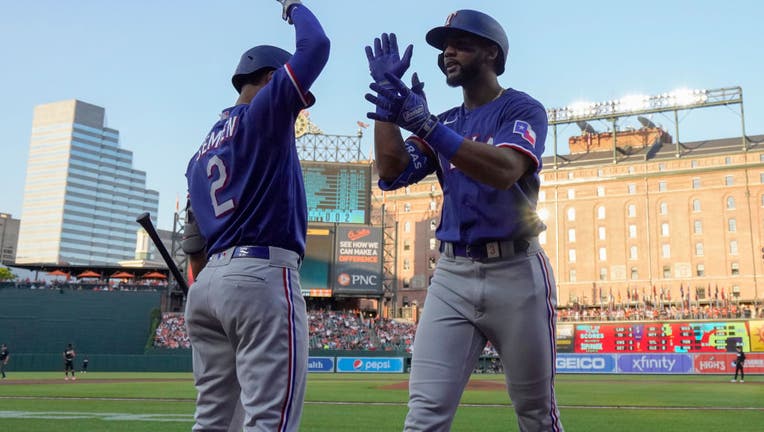How the Texas Rangers became MLB's top — and a potentially historic — offense

BALTIMORE, MARYLAND - MAY 26: Leody Taveras #3 celebrates with Marcus Semien #2 of the Texas Rangers after hitting a home run against the Baltimore Orioles during the first inning at Oriole Park at Camden Yards on May 26, 2023 in Baltimore, Maryland.
ARLINGTON, Texas - Do you know which baseball team has scored the most runs?
It is not the Tampa Bay Rays, who spent the season's first two months laying waste to the American League. It is not the Atlanta Braves with their star-studded lineup, or the Los Angeles Dodgers and their multiple former MVPs. It is certainly not the defending champion Houston Astros, who have woken up this season on the wrong side of the bed with no runs under their pillow.
No, the highest-scoring offense in MLB belongs to none other than the Texas Rangers.
The Rangers, a franchise that for the last half-decade has been mired in a slog of mediocrity, are one of the early season's best stories. A club that a year ago finished 14 games under .500 and fired both its president of baseball operations and its manager is 35-20, three games up on Houston in the American League west.
This is where the Rangers, and their vast financial might, should be. General manager Chris Young would tell you no different.
Because to call these Rangers a "surprise" glosses past the monumental investment made by ownership over the past two winters. The organization committed nearly $500 million after 2021 on Marcus Semien and Corey Seager before dropping nearly $300 million this past winter on Jacob deGrom, Nathan Eovaldi and Andrew Heaney.
It is not shocking that the Rangers are suddenly competing after spending roughly the GDP of Samoa on a wave of free agents. But take a look under the hood and you'll do a double take. And that's because this lineup is much, much more than its big-money bats (and is comically on pace to score the most runs of any team in 73 years).
Yes, Semien has been fantastic (.850 OPS) after a roller-coaster first year in Arlington and, yes, Seager has dominated (.943 OPS) when he's been healthy (just 24 games), but the Rangers are making a run at their first postseason berth since 2016 thanks to contributions from (1) a trio of shrewd, low-risk trade acquisitions and (2) a wave of former top prospects who have blossomed into everyday players.
Let's discuss that first group.
Nathaniel Lowe, Jonah Heim and Adolis García all became Rangers via trade relatively late in their careers after being signed and developed by other organizations. Lowe was 25 when the Rays shipped him to Texas, Heim was 26 when Oakland included him in the Elvis Andrus deal, and García was 27 when the Cardinals jettisoned him in exchange for ... cash considerations.
All three were players that any team could have had, and all three have become vital cogs in the Texas run-production machine.
García, who plays baseball like the world's most youthful 30-year-old, has an MLB-best 49 RBIs (an outdated stat that fits my narrative, deal with it) as Texas' everyday cleanup hitter. Just ahead of him in the order is Lowe, who has been penciled into the three spot for every single Rangers game so far this year. Meanwhile, Heim has inexplicably emerged into one of the better catchers in the American League, as his 1.9 fWAR ranks third across the majors.
Identifying and acquiring players like García, Lowe and Heim is such a vital part of a rebuild or a refresh or a reset or whatever you want to call this. Top prospects and big-money signings alone cannot save your soul. A team must be smart and savvy in the fallow periods, as the Rangers have been.
But let's not glaze past the prospects, either. Ezequiel Duran, Josh Jung and Leody Taveras, all of whom are 25 or younger, have played a huge role in fostering runs and good vibes over at Globe Life.
Duran, a second-year player who stepped in for Seager when the former Dodger hit the IL in April, has been spectacular on both sides of the ball. He has an 89th percentile ranking as a defensive shortstop to match an adjusted OPS 33% better than league average. His microscopic walk rate is a definitive red flag, but he makes so much good contact that it might not matter.
Jung was a first-round pick in 2019 out of Texas Tech who was expected to contribute last year, but missed a sizable chunk of the season with an injury. Well, now he’s healthy and raking. Jung’s 12 home runs lead all rookie hitters and he’s solidified himself as the true five-hole hitter in this lineup.
Tavares is a weird one. The 24-year-old outfielder first debuted for the Rangers during the pandemic-shortened 2020 season and held his own, but then struggled to make offensive improvements over the past two seasons and entered 2023 with real questions about his future. His outstanding defense in center field and speed on the bases gave him a nice floor, but nobody expected Taveras to rake the way he has. He’s striking out way less, walking way more and hitting the ball hard much more often than he had in the past.
There’s always a chance that one or more of this impressive sextet turns back into a pumpkin before the leaves turn red, leaving the Rangers scrambling for a replacement. But so far, so good in Arlington. We’ve seen a fascinating offensive resurgence for an organization that desperately needed one.
This story first appeared on FOXSports.com. READ MORE: How the Texas Rangers became MLB's top — and a potentially historic — offense

